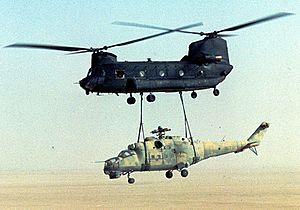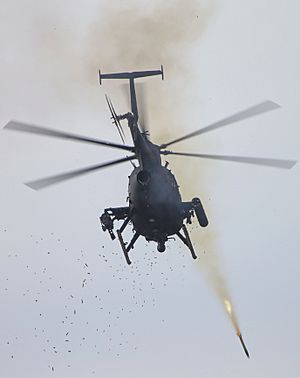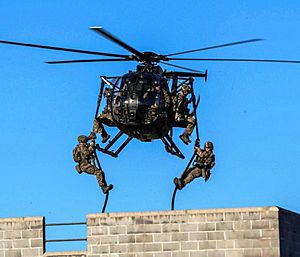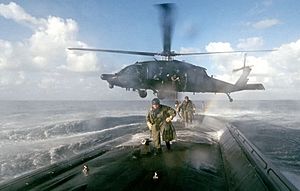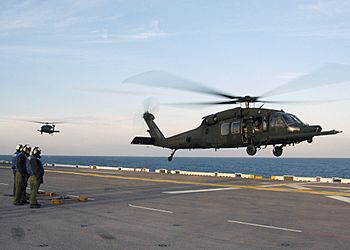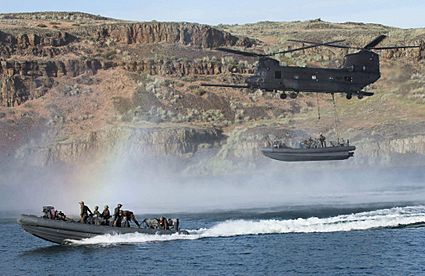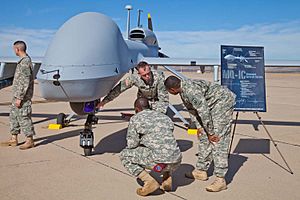160th Special Operations Aviation Regiment (Airborne) facts for kids
Quick facts for kids 160th Special Operations Aviation Regiment (Airborne) |
|
|---|---|

Regimental distinctive unit insignia
|
|
| Founded | 1981 |
| Country | |
| Branch | |
| Type | Special operations aviation |
| Size | 2,700 |
| Part of | |
| Garrison/HQ | Fort Campbell, Kentucky, U.S. |
| Nickname(s) | "Night Stalkers", "160th SOAR (A)", "Task Force Brown" |
| Motto(s) | "Night Stalkers don't quit!", "Death waits in the dark!", "Six guns don't miss!" |
| Color of berets | Maroon |
| Engagements | Invasion of Grenada Operation Mount Hope III Operation Earnest Will Operation Prime Chance Invasion of Panama Persian Gulf War Operation Neptune Spear Somali Civil War Operation Restore Hope |
| Insignia | |
| U.S. Army Special Operations Aviation Command Shoulder Sleeve Insignia, worn by the 160th SOAR (A) | |
The 160th Special Operations Aviation Regiment (Airborne), also known as the 160th SOAR (A), is a special team in the United States Army. They fly helicopters to help other special forces. Their jobs often involve attacking, transporting troops, and scouting. They usually do these missions at night, flying very fast and low to the ground, often with little warning.
This group is nicknamed the Night Stalkers. They are based at Fort Campbell, Kentucky.
Contents
Becoming a Night Stalker
The 160th SOAR (A) is made up of the Army's most skilled pilots, crew members, and support soldiers. Officers volunteer for this unit. Enlisted soldiers can volunteer or be assigned. Until 2013, only men could be pilots in the 160th.
When soldiers join the 160th, they go through intense training called "Green Platoon." Here, they learn advanced skills like first aid, how to navigate on land, combat moves, using weapons, and teamwork. They practice shooting thousands of rounds with different types of guns. Not everyone passes this course, but those who do become Night Stalkers. The basic course for enlisted soldiers lasts five weeks. For officers, it takes 20 to 28 weeks.
A new Night Stalker pilot starts as "Basic Mission Qualified" (BMQ). After up to three years of tests and training, they become "Fully Mission Qualified" (FMQ). After three to five years as an FMQ, they can try to become a flight leader.
Special medics in the SOAR can become special operations combat medics. They do this by finishing a 36-week course at Fort Bragg.
History of the Night Stalkers
How the Unit Started
In 1980, a mission to rescue American hostages in Tehran, Iran, failed. After this, President Jimmy Carter asked military leaders to find a better way to do such missions. At that time, the U.S. military did not have helicopter units trained for secret, quick special operations.
The Army looked to the 101st Aviation Group, which was part of the 101st Airborne Division. This group had the most experience with helicopters. They chose pilots from several battalions, and these pilots immediately began intense night flying training.
This new group was called Task Force 158. Most of its pilots came from the 158th Aviation Battalion. They kept their "Screaming Eagle" patches from the 101st Division. Their helicopters, like the Black Hawks and Chinooks, trained at different airfields. Special OH-6 Cayuse helicopters, which were not usually used by the division, were hidden on base for secret operations.
By late 1980, the first pilots finished their training. A second rescue mission was planned for early 1981. But the hostages were released on the day President Ronald Reagan became president, so the mission was called off.
Task Force 158 was the only special operations aviation unit in the Army. Its members were known as the best night helicopter pilots. Their skills were too important to lose. So, instead of going back to the 101st, the pilots and their special aircraft formed a new unit. On October 16, 1981, this unit officially became the 160th Aviation Battalion.
The 160th first saw combat in 1983 during Operation Urgent Fury, the U.S. invasion of Grenada.
In 1986, the unit was renamed the 160th Aviation Group (Airborne). In May 1990, it became the 160th Special Operations Aviation Regiment (Airborne). As more special operations aviation was needed, the regiment grew. It added three battalions and one Army National Guard unit.
Missions in the 1980s and 1990s
In 1987 and 1988, Night Stalker pilots helped protect Kuwaiti oil tankers in the Persian Gulf during the Iran–Iraq War. This was part of Operation Earnest Will. They flew from U.S. Navy ships and special oil barges in a secret mission called Operation Prime Chance. They were the first helicopter pilots to use night vision goggles and special heat-sensing devices (FLIR) in night combat.
In June 1988, the unit got a quick order to get a Soviet-made Mi-25 Hind attack helicopter from a faraway place in Chad. The Libyans had left the helicopter, and it was very valuable for U.S. intelligence. Two CH-47 Chinooks, a U.S. Air Force C-5 Galaxy plane, and 75 crew members practiced the mission in New Mexico. In late May, a team went to Ndjamena, Chad. Two weeks later, the Chinooks and crew arrived. On June 11, 1988, two MH-47s flew 490 miles at night to the Ouadi Doum Airfield in northern Chad. One Chinook landed to prepare the Hind, while the other hovered above. They lifted the Hind and flew it back to Ndjamena. A sandstorm made the trip harder, but the mission was completed in less than 67 hours.
The Night Stalkers led the way in Operation Just Cause, the 1989 invasion of Panama. They also took part in Operation Desert Storm in 1991.
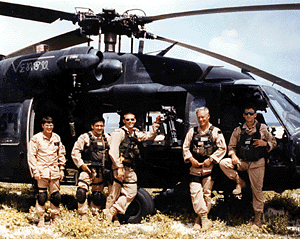
In October 1993, in Somalia, Night Stalkers were involved in the Battle of Mogadishu. This battle later became famous from the book Black Hawk Down and its movie. Two Night Stalker Black Hawks, Super 6-1 and Super 6-4, were shot down. Five Night Stalkers were among the 18 soldiers killed in the battle.
Global War on Terrorism
2001–2005
During the 2001 invasion of Afghanistan, Night Stalkers from the 2nd Battalion supported two task forces. On the night of October 18, 2001, two SOAR MH-47E helicopters, with MH-60L (Direct Action Penetrators) (DAPs) as escorts, flew U.S. troops over 300 kilometers across the 16,000-foot Hindu Kush mountains into Afghanistan.
The Chinook pilots flew in conditions where they could see almost nothing. They refueled in the air three times during the 11-hour mission. This set a new world record for combat helicopters. The troops were Green Beret teams and Air Force Combat Controllers. They joined forces with the CIA and the Northern Alliance. Within a few weeks, the Northern Alliance, with U.S. help, captured important cities from the Taliban.
In November 2001, Night Stalker AH-6J Little Birds took part in missions called Objective Wolverine, Raptor, and Operation Relentless Strike. In December 2001, Night Stalker crews brought supplies to over 150 Delta Force, British Special Boat Service, and CIA operatives. They were hunting for Osama bin Laden in the Tora Bora mountains.
On February 21, 2002, a MH-47 crashed at sea in the southern Philippines. Ten servicemen died, including eight from the 160th SOAR. They were looking for terrorists and trying to rescue a nurse and missionaries.
In March 2002, Night Stalkers supported troops during Operation Anaconda in Afghanistan. During the Battle of Takur Ghar on March 4, one of their MH-47Es, called Razor 03, was hit by rockets and crash-landed. A second MH-47E, Razor 01, came to help but was also hit and crash-landed. One Night Stalker died in this battle.
On June 21, 2002, in the Philippines, Night Stalker MH-47Es helped kill Abu Sabaya, a leader in Abu Sayyaf. A U.S. drone marked him with a laser. The MH-47Es shined lights on his boat, and Philippine special forces opened fire, killing him and capturing four others.
During the 2003 invasion of Iraq, the 3rd Battalion, 160th SOAR, was part of the Joint Special Operations Air Detachment-West. They had MH-47E Chinooks, MH-60L DAPs, and MH-60M Black Hawks. On March 19, 2003, the 160th SOAR carried out the first strike of Operation Iraqi Freedom. They attacked Iraqi observation posts along the borders. The strike groups included MH-60L DAPs and "Black Swarm" flights of AH-6M Little Birds.
In seven hours, over 70 sites were destroyed. This prevented the Iraqi military from knowing about the coming invasion. As these sites were taken out, the first special forces teams launched from Jordan. These teams, including British and Australian special forces, were transported by the 160th SOAR's MH-47Es. Night Stalkers from the 1st Battalion, 160th SOAR, also supported Task Force 20 with their helicopters. On March 26, the 160th SOAR took part in the Objective Beaver mission. This was a raid by DEVGRU on a research center thought to have chemical and biological weapons.
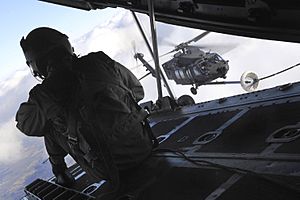
On April 1, 2003, the 160th SOAR helped rescue PFC Jessica Lynch. She was taken prisoner during the Battle of Nasiriyah. On April 2, a Delta Force team in Iraq was attacked. Two MH-60K Black Hawks with medics and two MH-60L DAPs from the 160th SOAR responded. They fought the Iraqis, allowing the Delta operators to move their injured soldiers. One Delta Force operator died from his wounds.
On December 13, 2003, Saddam Hussein was captured by U.S. forces in Operation Red Dawn. A MH-6 Little Bird from the 160th SOAR took him to Baghdad International Airport.
In 2004, they helped rescue three Italian workers and one Polish businessman held for ransom in Iraq.
In Afghanistan in 2005, eight Night Stalkers and eight Navy SEALs were killed. Their MH-47 Chinook helicopter was hit by a rocket propelled grenade. They were on a rescue mission for Marcus Luttrell after his team was attacked.
2006–2009
In March 2006, SEALs and Rangers were flown by the 160th SOAR into North Waziristan, Pakistan. They attacked an al-Qaeda training camp, killing about 30 terrorists.
On May 14, 2006, 160th SOAR helicopters brought Delta Force operators to Yusufiyah, Iraq, to fight al-Qaeda. As the operators left the helicopters, they were shot at. The helicopter gunners fired back, and AH-6M Little Birds attacked from the air. One Little Bird was shot down. About 25 al-Qaeda fighters were killed.
In July 2006, two MH-47Es from 160th SOAR tried to drop off a team of DEVGRU, Rangers, and Afghan commandos in Helmand Province, Afghanistan. A large enemy force attacked them. Both helicopters were hit by gunfire. One MH-47E pilot put his aircraft in the line of fire to protect the other helicopter. This helicopter was hit by a rocket and crash-landed, but no one was seriously hurt. The other MH-47E fought back until it ran out of ammunition. An AC-130 Spectre gunship then joined the fight, keeping the downed crew safe until a British helicopter rescued them. The AC-130 then destroyed the crashed helicopter to keep it from the Taliban.
Parts of the 3rd Battalion, 160th SOAR, have been deployed to support Operation Enduring Freedom – Caribbean and Central America since 2008. Night Stalker helicopters were also part of counter-terror exercises in Denver in 2008. On April 24, 2008, Company D, 3rd Battalion, 160th SOAR, was closed down as part of a plan to change the regiment. The 160th SOAR also took part in the 2008 Abu Kamal raid.
On August 19, 2009, four Night Stalkers from D Company, 1st Battalion, 160th SOAR, died in a MH-60 Black Hawk helicopter crash in Leadville, Colorado. This happened during mountain training. On September 9, 2009, in Afghanistan, Night Stalkers helped British special forces rescue journalist Stephen Farrell after he was captured by the Taliban. On September 19, 2009, in Somalia, the Night Stalkers took part in Operation Celestial Balance. They used AH-6M Little Birds and MH-60L Black Hawks to carry DEVGRU operators to kill or capture a terrorist leader. The helicopters attacked the leader's vehicles, killing him and three other terrorists.
On October 22, 2009, a 3rd Battalion helicopter crashed into the USNS Arctic ship during a training exercise. One soldier died, and eight others were injured.
2010–2020
In May 2011, the Night Stalkers took part in the raid on Osama bin Laden's compound. They flew two special, stealthy MH-60 Black Hawk helicopters into Abbotabad, Pakistan. These helicopters carried Navy SEALs directly to bin Laden's compound. One helicopter crash-landed when it arrived, but everyone on board survived. The SEALs completed their mission, and the helicopter crew was able to get out safely and leave on the other helicopter. This mission was a success. The dramatic night raid was shown in the movie Zero Dark Thirty.
On May 28, 2012, Operation Jubilee happened. Black Hawks from the 160th SOAR flew British and DEVGRU teams into Badakhshan Province, Afghanistan. They rescued a British aid worker, a Kenyan aid worker, and two Afghans who were taken hostage. The rescue was successful.
On January 15, 2014, a MH-60M Black Hawk from the 160th made a hard landing at Hunter Army Airfield in Georgia. One soldier died, and two others were injured. On July 4, 2014, during Operation Inherent Resolve, Night Stalkers flew Delta Force operators into Syria. They were trying to rescue James Foley and other U.S. hostages. One American was wounded, and no hostages were found, but many terrorists were killed. On November 26, 2014, MH-60s flown by Nightstalkers took part in the first raid of the 2014 hostage rescue operations in Yemen.
The Night Stalkers continue to be in Afghanistan as part of NATO's Resolute Support Mission. This mission replaced Operation Enduring Freedom-Afghanistan in late 2014. On the night of December 5, 2015, Rangers fought enemy troops near the Afghan-Pakistan border. Their commander called for extraction when a larger enemy group approached. A helicopter from the 160th SOAR arrived and came under heavy fire. An AH-64 Apache helicopter from the 1st Battalion 101st Aviation Regiment flew between the U.S. troops and the enemy to draw fire. This helped the extraction succeed.
The Washington Post reported that the 160th SOAR took part in the Yakla raid in Yemen on January 29, 2017. Their helicopters flew into heavy enemy fire many times to help U.S. Navy SEALs who were pinned down. On August 25, 2017, a Black Hawk helicopter from the 160th SOAR crashed off the coast of Yemen during training. It lost power and fell into the sea. Six servicemen survived, but one U.S. service member was missing. CNN reported that on October 27, 2017, a U.S. helicopter from the 4th Battalion, 160th SOAR, crashed in Logar province, Afghanistan. One person died, and six were injured. The crash was not caused by enemy action.
On August 20, 2018, CW3 Taylor Galvin died from injuries after an MH-60M crashed. This happened during a counter-terrorism mission supporting Operation Inherent Resolve.
Aircraft Used
| Aircraft | Origin | Type | Variant | In service | Notes |
|---|---|---|---|---|---|
| Helicopters | |||||
| Boeing CH-47 | United States | transport / CSAR | MH-47G | 71 | |
| Sikorsky UH-60 | United States | utility | MH-60L/M | 72 | Some L models were upgraded to Direct Action Penetrator (DAP) variants |
| MD500 Defender | United States | light attack | AH/MH-6 | 47 | M variants can be equipped with the Fast Rope Insertion Extraction System (FRIES) |
| Unmanned Aerial Vehicles (UAVs) | |||||
| General Atomics MQ-1 | United States | surveillance | MQ-1C | 12 | |
Known Operations
| Operation | Country | Year |
|---|---|---|
| Operation Urgent Fury | Grenada |
|
| Operation Prime Chance | Persian Gulf |
|
| Operation Mount Hope III | Chad |
|
| Operation Just Cause | Panama |
|
| Operation Desert Shield | Iraq |
|
| Operation Desert Storm | Iraq |
|
| Operation Restore Hope | Somalia |
|
| Operation Gothic Serpent | Somalia |
|
| Operation Enduring Freedom | Afghanistan / Pakistan |
|
| Operation Iraqi Freedom | Iraq |
|
| Operation Celestial Balance | Somalia |
|
| Operation New Dawn | Iraq |
|
| Operation Neptune Spear | Pakistan |
|
| Operation Inherent Resolve | Syria / Iraq |
|
| Operation Kayla Mueller | Syria |
|
How the Unit is Organized
160th Special Operations Aviation Regiment (Airborne) (160th SOAR (A))
| Beret flash | Unit | Location |
|---|---|---|
 |
160th SOAR(A)
|
Fort Campbell, Kentucky |
 |
1st Battalion, 160th SOAR(A)
|
Fort Campbell, Kentucky |
 |
2nd Battalion, 160th SOAR(A)
|
Fort Campbell, Kentucky |
 |
3rd Battalion, 160th SOAR(A)
|
Hunter Army Airfield, Georgia |
 |
4th Battalion, 160th SOAR(A)
|
Gray AAF/Joint Base Lewis-McChord, Washington |
See also
 In Spanish: 160.º Regimiento de Aviación de Operaciones Especiales para niños
In Spanish: 160.º Regimiento de Aviación de Operaciones Especiales para niños



